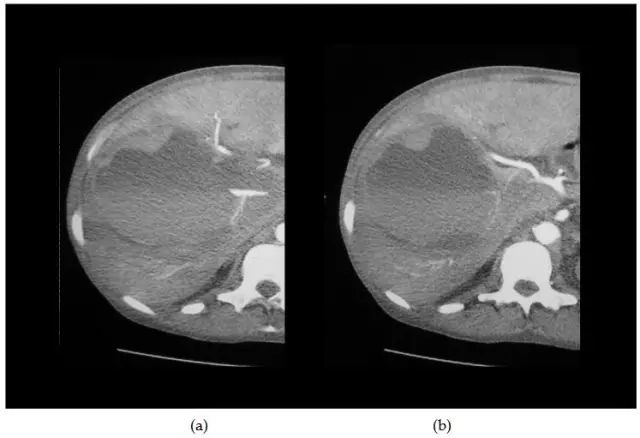- Author Rachel Wainwright [email protected].
- Public 2023-12-15 07:39.
- Last modified 2025-11-02 20:14.
Colonoscopy

There are several methods for examining the intestines today, but the most reliable method for detecting colon cancer is colonoscopy. Palpation of the abdomen, laboratory tests, and radiation diagnostic methods (X-ray, ultrasound, tomography) also help the doctor in making a diagnosis. Nevertheless, only colonoscopy of the intestine allows you to look inside without surgery and directly examine the state of the intestinal wall.
Indications for colonoscopy of the intestine
Doctors recommend a colonoscopy to clarify the diagnosis for patients with the following symptoms:
- black stools;
- blood in the stool;
- Iron-deficiency anemia;
- persistent diarrhea;
- serious unexplained weight loss;
- ulcerative colitis;
- pathology revealed by X-ray examination of the colon;
- colon polyps;
- chronic abdominal pain.
Colonoscopy should be done if the patient has a family history of colon cancer.
In general, the indication for colonoscopy of the intestine is the suspicion of any of the possible diseases of the colon. In some cases, for diagnosis, an irrigoscopy is first prescribed - an X-ray examination of the colon, however, if a tumor is suspected, it is most often recommended to do a colonoscopy, since its resolution is much higher.
Contraindications
- acute infectious diseases;
- peritonitis;
- late stage of pulmonary or heart failure;
- severe forms of ischemic and ulcerative colitis.
Preparing for a colonoscopy
In order for the results of the study to be as accurate as possible, there should be no liquid or feces in the lumen of the colon. For this, special preparation for colonoscopy is carried out.

In a few days, the doctor will determine the exact amount, the patient switches to a diet that excludes slag products from the diet: legumes, fresh fruits and vegetables, cabbage, black bread, some cereals.
Also, an obligatory stage in preparation for a colonoscopy is bowel cleansing, which is possible in two ways: medication or mechanical (i.e. using enemas). In the first case, the doctor usually prescribes a special drug Fortrans, which is taken the day before the study. In the second case, 2-3 cleansing enemas are given in the evening on the day preceding the procedure, and 2-3 in the morning immediately before the diagnosis.
When choosing a specific method of preparing for a colonoscopy, you should definitely consult with your doctor.
Colonoscopy under anesthesia or without anesthesia?
Usually, a colonoscopy is performed without anesthesia; patients with severe pain in the area are given local anesthesia (xylocaine gel, dicaine ointment).
Many patients, being afraid to do this procedure, are interested in whether a colonoscopy is possible under general anesthesia. Doctors say that the vast majority of this examination does not cause severe pain. Moreover, in a number of conditions, anesthesia during colonoscopy of the intestine simply cannot be done, including with severe heart failure, severe stenosis of the aortic or mitral valve, with exacerbation of broncho-pulmonary diseases, with acute psychiatric and neurological diseases.
But there are situations when colonoscopy under anesthesia is preferable, and there are also indications for this, for example, massive adhesions in the abdominal cavity, severe destructive processes in the small intestine, children under 10 years of age.
Therefore, colonoscopy under local anesthesia is used extremely rarely, if there is a need for anesthesia, then sedation is given preference - the method of anesthesia with special drugs, with the help of which a person is immersed in a state of superficial drug sleep.
Technique of the procedure
A colonoscopy performed by an experienced physician takes approximately 30 minutes. Before starting the procedure, the patient is given a relaxing medication. The patient lies on the couch on his left side, pulling his knees to his chest. The colonoscope is used - a long flexible instrument, approximately 1 cm in diameter. This device is inserted through the anus and, with a moderate supply of air to expand the intestines, is gradually pushed forward. To facilitate the advancement of the apparatus, the patient may be asked to change position - to roll over onto his back.
At the moment of overcoming the bowel bends, a person may feel discomfort, mild spasms and a short-term increase in pain.
If during a colonoscopy, the doctor notices any pathology, he does a biopsy - removes small tissue samples for further analysis, which will help determine the nature of the formation. In this case, the research time is slightly increased.
Complications after colonoscopy
Complications after colonoscopy of the intestine are practically not observed. In rare cases, it happens:
- bleeding can occur after removal of the polyp or biopsy, but it is usually minimal and stops very quickly;
- an adverse reaction to a sedative;
- rupture in the examined tissues is extremely rare, the quality of the examination depends on the professionalism of the medical staff.
Found a mistake in the text? Select it and press Ctrl + Enter.






